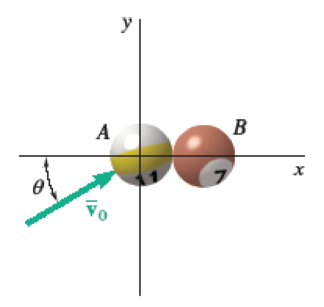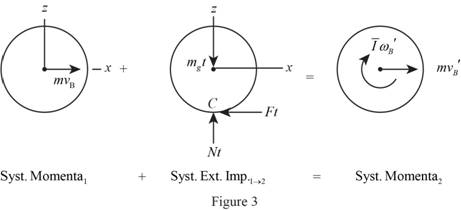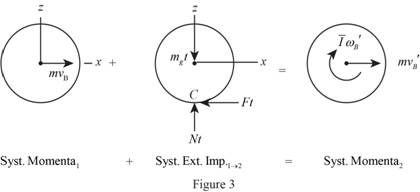
Concept explainers
In a game of pool, ball A is rolling without slipping with a velocity

Fig. P17.133
a)
The linear and angular velocity of each ball immediately after the impact.
Answer to Problem 17.133P
The linear velocity of ball A immediately after the impact is
The angular velocity of ball A immediately after the impact is
The linear velocity of ball B immediately after the impact is
The angular velocity of ball B immediately after the impact is
Explanation of Solution
Given information:
The mass of the each ball is m.
The radius of the each ball is r.
The velocity of the ball A before the impact is
The coefficient of kinetic friction between a ball and the table
Calculation:
Write the equation of moment of inertia
Analyze the impact of ball A.
Here, G is the mass center of ball A.
Consider the conservation of momentum principle.
Sketch the impulse and momentum diagram of the ball A as shown in Figure 1.

Here,
Refer Figure (1).
Consider the kinematics in position 1.
Write the equation of angular velocity
Consider the horizontal components of forces.
Consider the vertical components of forces.
Take moments about y axis.
Take moments about x axis.
Analyze the impact of ball B.
Here, G is the mass center of ball B.
Consider the conservation of momentum principle.
Sketch the impulse and momentum diagram of the ball B as shown in Figure (2).

Here,
Refer Figure (2),
Consider the horizontal components of forces.
Consider the vertical components of forces.
Take moments about y axis.
Take moments about x axis.
Add Equations (1) and (5).
The impact is perfectly plastic. Therefore ,the coefficient of restitution (e) is 1.
Consider the condition of impact equation.
Substitute 1 for e.
Find the horizontal components of linear velocity
Solve Equations (9) and (10) simultaneously.
Add Equations (9) and (10).
Find the horizontal components linear velocity
Substitute
Find the vertical components of linear velocity
Find the vertical components of linear velocity
Find the linear velocity
Substitute 0 for
Thus, the linear velocity of ball A immediately after the impact is
Find the linear velocity
Substitute
Thus, the linear velocity of ball B immediately after the impact is
Find the initial angular velocity of ball A using kinematics.
Find the angular velocity
Solve Equations (3) and (4) simultaneously.
Add Equations (3) and (4).
Substitute
Thus, the angular velocity of ball A immediately after the impact is
Find the angular velocity
From Equations (7) and (8).
Thus, the angular velocity of ball B immediately after the impact is
b)
Find the velocity of ball B after it has started rolling uniformly.
Answer to Problem 17.133P
The velocity of ball B after it has started rolling uniformly is
Explanation of Solution
Calculation:
Consider the motion after impact of ball B.
Consider C is the mass center of ball A.
Consider the conservation of momentum principle.
Sketch the motion of impulse and momentum diagram of the ball A after the impact as shown in Figure (3).

Here,
Consider the condition of rolling without slipping in kinematics.
Refer Figure (3).
Take moments about C:
Substitute
Find the velocity of sphere A after it has started rolling uniformly using the equation:
Substitute
Thus, the velocity of ball A after it has started rolling uniformly is
Consider the motion after impact of ball A.
Consider C is the mass center of ball A.
Consider the conservation of momentum principle.
Sketch the motion of impulse and momentum diagram of the ball B after the impact as shown in Figure (3).

Here, N is the normal force on ball A, F is the friction force between ball and floor, t is the rolling time,
Consider the condition of rolling without slipping in kinematics.
Refer Figure (3),
Take moments about C:
Substitute
Find the velocity of sphere B after it has started rolling uniformly using the equation:
Substitute
Thus, the velocity of sphere B after it has started rolling uniformly is
Want to see more full solutions like this?
Chapter 17 Solutions
VECTOR MECHANIC
Additional Engineering Textbook Solutions
Automotive Technology: Principles, Diagnosis, And Service (6th Edition) (halderman Automotive Series)
Starting Out with C++: Early Objects (9th Edition)
Management Information Systems: Managing The Digital Firm (16th Edition)
Vector Mechanics For Engineers
Starting Out with Java: From Control Structures through Objects (7th Edition) (What's New in Computer Science)
Starting Out with Python (4th Edition)
- Qu. 3 The automobile is originally at rest s = 0. If it then starts to increase its speed at i = (0.05t2)ft/s?, where t is in seconds, determine the magnitudes of its velocity and acceleration at s = 550 ft. please show all work from dynamics step by step formulaarrow_forwardquestion 5 and 6 from dynamics I need to show all work step by step problemsarrow_forwardStudy Area Document Sharing User Settings Access Pearson mylabmastering.pearson.com P Pearson MyLab and Mastering The crash cushion for a highway barrier consists of a nest of barrels filled with an impact-absorbing material. The barrier stopping force is measured versus the vehicle penetration into the barrier. (Figure 1) Part A P Course Home b My Questions | bartleby Review Determine the distance a car having a weight of 4000 lb will penetrate the barrier if it is originally traveling at 55 ft/s when it strikes the first barrel. Express your answer to three significant figures and include the appropriate units. Figure 1 of 1 36 μΑ S = Value Units Submit Request Answer Provide Feedback ? Next >arrow_forward
- Water is the working fluid in an ideal Rankine cycle. Saturated vapor enters the turbine at 12 MPa, and the condenser pressure is 8 kPa. The mass flow rate of steam entering the turbine is 50 kg/s. Determine: (a) the net power developed, in kW. (b) the rate of heat transfer to the steam passing through the boiler, in kW. (c) the percent thermal efficiency. (d) the mass flow rate of condenser cooling water, in kg/s, if the cooling water undergoes a temperature increase of 18°C with negligible pressure change in passing through the condenser.arrow_forward4. The figure below shows a bent pipe with the external loading FA 228 lb, and M₁ = M₂ = 1 kip-ft. The force Fernal loading FA = 300 lb, FB: parallel to the y-axis, and and yc = 60°. = 125 lb, Fc = acts parallel to the x-z plane, the force FB acts Cartesian resultan Coordinate direction angles of Fc are ac = 120°, ẞc = 45°, a. Compute the resultant force vector of the given external loading and express it in EST form. b. Compute the resultant moment vector of the given external loading about the origin, O, and express it in Cartesian vector form. Use the vector method while computing the moments of forces. c. Compute the resultant moment vector of the given external loading about the line OA and express it in Cartesian vector form. :00 PM EST k ghoufran@buffaternal du 2 ft M₁ A 40° FA M2 C 18 in 1 ft Fc 25 houfran@bald.edu - Feb 19, 3 ft FBarrow_forwardThe differential equation of a cruise control system is provided by the following equation: Find the closed loop transfer function with respect to the reference velocity (vr) . a. Find the poles of the closed loop transfer function for different values of K. How does the poles move as you change K? b. Find the step response for different values of K and plot in MATLAB. What can you observe? c. For the given transfer function, find tp, ts, tr, Mp . Plot the resulting step response. G(s) = 40/(s^2 + 4s + 40)arrow_forward
- Auto Controls Perform the partial fraction expansion of the following transfer function and find the impulse response: G(s) = (s/2 + 5/3) / (s^2 + 4s + 6) G(s) =( 6s^2 + 50) / (s+3)(s^2 +4)arrow_forwardStudy Area Document Sharing User Settings mylabmastering.pearson.com Access Pearson P Pearson MyLab and Mastering The 150-lb skater passes point A with a speed of 6 ft/s. (Figure 1) Figure 1 of 1 Part A P Course Home b My Questions | bartleby Determine his speed when he reaches point B. Neglect friction. Express your answer to three significant figures and include the appropriate units. με ? VB = Value Units Submit Request Answer Part B Determine the normal force exerted on him by the track at this point. Express your answer to three significant figures and include the appropriate units. ☐ о Α NB = Value Units Submit Request Answer Provide Feedback ? ■Review Next >arrow_forwardmylabmastering.pearson.com Access Pearson P Pearson MyLab and Mastering P Course Home b My Questions | bartleby Study Area Document Sharing User Settings The 100-kg crate is subjected to the forces shown. The crate is originally at rest. The coefficient of kinetic friction between the crate and the surface is μk = 0.2. (Figure 1) Part A Determine the distance it slides in order to attain a speed of 8.1 m/s. Express your answer to three significant figures and include the appropriate units. Figure 500 N 1 of 1 Α S = Value Units Submit Request Answer Provide Feedback ? ■Review Next >arrow_forward
- The differential equation of a DC motor can be described by the following equation Find the transfer function between the applied voltage ( Va)and the motor speed (thetadot m). What is the steady state speed of the motor after a voltage (Va = 10V) has been applied. Find the transfer function between the applied voltage (Va) and the shaft angle (thetadot m) .arrow_forwardStudy Area Document Sharing User Settings Access Pearson mylabmastering.pearson.com P Pearson MyLab and Mastering The crash cushion for a highway barrier consists of a nest of barrels filled with an impact-absorbing material. The barrier stopping force is measured versus the vehicle penetration into the barrier. (Figure 1) Part A P Course Home b My Questions | bartleby Review Determine the distance a car having a weight of 4000 lb will penetrate the barrier if it is originally traveling at 55 ft/s when it strikes the first barrel. Express your answer to three significant figures and include the appropriate units. Figure 1 of 1 36 μΑ S = Value Units Submit Request Answer Provide Feedback ? Next >arrow_forwardStudy Area Document Sharing User Settings mylabmastering.pearson.com Access Pearson P Pearson MyLab and Mastering Part A P Course Home b My Questions | bartleby ■Review The sports car has a mass of 2.5 Mg and accelerates at 6 m/s², starting from rest. (Figure 1) If the drag resistance on the car due to the wind is FD = (10v) N, where v is the velocity in m/s, determine the power supplied to the engine when t = 5 s. The engine has a running efficiency of € = 0.66. Express your answer to three significant figures and include the appropriate units. Figure 1 of 1 о Α ? P = Value Units Submit Request Answer Return to Assignment Provide Feedbackarrow_forward
 Elements Of ElectromagneticsMechanical EngineeringISBN:9780190698614Author:Sadiku, Matthew N. O.Publisher:Oxford University Press
Elements Of ElectromagneticsMechanical EngineeringISBN:9780190698614Author:Sadiku, Matthew N. O.Publisher:Oxford University Press Mechanics of Materials (10th Edition)Mechanical EngineeringISBN:9780134319650Author:Russell C. HibbelerPublisher:PEARSON
Mechanics of Materials (10th Edition)Mechanical EngineeringISBN:9780134319650Author:Russell C. HibbelerPublisher:PEARSON Thermodynamics: An Engineering ApproachMechanical EngineeringISBN:9781259822674Author:Yunus A. Cengel Dr., Michael A. BolesPublisher:McGraw-Hill Education
Thermodynamics: An Engineering ApproachMechanical EngineeringISBN:9781259822674Author:Yunus A. Cengel Dr., Michael A. BolesPublisher:McGraw-Hill Education Control Systems EngineeringMechanical EngineeringISBN:9781118170519Author:Norman S. NisePublisher:WILEY
Control Systems EngineeringMechanical EngineeringISBN:9781118170519Author:Norman S. NisePublisher:WILEY Mechanics of Materials (MindTap Course List)Mechanical EngineeringISBN:9781337093347Author:Barry J. Goodno, James M. GerePublisher:Cengage Learning
Mechanics of Materials (MindTap Course List)Mechanical EngineeringISBN:9781337093347Author:Barry J. Goodno, James M. GerePublisher:Cengage Learning Engineering Mechanics: StaticsMechanical EngineeringISBN:9781118807330Author:James L. Meriam, L. G. Kraige, J. N. BoltonPublisher:WILEY
Engineering Mechanics: StaticsMechanical EngineeringISBN:9781118807330Author:James L. Meriam, L. G. Kraige, J. N. BoltonPublisher:WILEY





